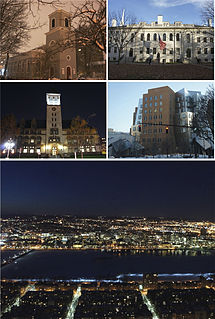
Cambridge is a city in Middlesex County, Massachusetts, and part of the Boston metropolitan area as a major suburb of Boston. As of July 2019, it was the fifth most populous city in the state, behind Boston, Worcester, Springfield, and Lowell. According to the 2010 Census, the city's population was 105,162. It is one of two de jure county seats of Middlesex County, although the county's government was abolished in 1997. Situated directly north of Boston, across the Charles River, it was named in honor of the University of Cambridge in England, once also an important center of the Puritan theology embraced by the town's founders.
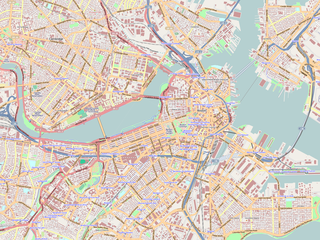
Back Bay is an officially-recognized neighborhood of Boston, Massachusetts, built on reclaimed land in the Charles River basin. Construction began in 1859, as the demand for luxury housing exceeded the availability in the city at the time, and the area was fully built by around 1900. It is most famous for its rows of Victorian brownstone homes—considered one of the best preserved examples of 19th-century urban design in the United States—as well as numerous architecturally significant individual buildings, and cultural institutions such as the Boston Public Library. Initially conceived as a residential-only area, commercial buildings were permitted from around 1890, and Back Bay now features many office buildings, including the John Hancock Tower, Boston's tallest skyscraper. It is also considered a fashionable shopping destination and home to several major hotels.

Davis Square is a major intersection in the northwestern section of Somerville, Massachusetts where several streets meet: Holland Street, Dover Street, Day Street, Elm Street, Highland Avenue, and College Avenue. The name is often used to refer to the West Somerville neighborhood surrounding the square as well.

Alewife station is an Massachusetts Bay Transportation Authority (MBTA) intermodal transit station in the North Cambridge neighborhood of Cambridge, Massachusetts. It is the northwest terminal of the rapid transit Red Line and a hub for several MBTA bus routes. The station is located off Alewife Brook Parkway adjacent to the eastern end of the freeway portion of Massachusetts Route 2, with a five-story parking garage for park and ride use. Located at the confluence of the Minuteman Bikeway, Alewife Linear Park, Fitchburg Cutoff Path, and Alewife Greenway, the station has three bike cages. Alewife station is named after nearby Alewife Brook Parkway and Alewife Brook, themselves named after the alewife fish.

The Minuteman Bikeway is a 10-mile (16-kilometre) paved multi-use rail trail located in the Greater Boston area of Massachusetts. It runs from Bedford to Alewife station, at the northern end of the Red Line in Cambridge, passing through the towns of Lexington and Arlington along the way. Also along the route are several notable regional sites, including Alewife Brook Reservation, Spy Pond, "Arlington’s Great Meadows", the Battle Green in Lexington, and Hanscom Air Force Base.
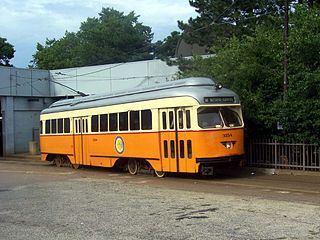
Mattapan is a neighborhood in Boston, Massachusetts. Historically a section of neighboring Dorchester, Mattapan became a part of Boston when Dorchester was annexed in 1870. As of the 2010 census, it had a population of 36,480, with the majority of its population immigrants. Like other neighborhoods of the late 19th and early 20th century, Mattapan developed, residentially and commercially, as the railroads and streetcars made downtown Boston increasingly accessible. Predominantly residential, Mattapan is a mix of public housing, small apartment buildings, single-family houses, and two- and three-family houses. Blue Hill Avenue and Mattapan Square, where Blue Hill Avenue, River Street, and Cummins Highway meet, are the commercial heart of the neighborhood, home to banks, law offices, restaurants, and retail shops. The new Mattapan Branch of the Boston Public library opened 2009, at a cost of more than $4 million. Mattapan has a large portion of green space within the neighborhood. The Harambee Park, the Franklin Park Zoo, the Boston Nature Center and Wildlife Sanctuary, Clark-Cooper Community Gardens, and historic Forest Hill Cemetery can all be considered green space within the neighborhood of Mattapan. Mattapan's demographics are diverse, with a large population of Haitians, Caribbean immigrants, and African Americans. Mattapan has public services such as a recently renovated community health center, and constable services. Mattapan has a trolley running through it, which is accessible via Ashmont.
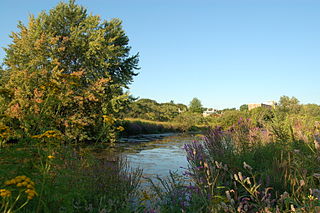
Alewife Brook Reservation is a Massachusetts state park and urban wild located in Cambridge, Arlington, and Somerville. The park is managed by the state Department of Conservation and Recreation and was established in 1900. It is named for Alewife Brook, which was also historically known as Menotomy River, a tributary of the Mystic River.

The Harbor Towers are two 40-story residential towers located on the waterfront of Boston, Massachusetts, located between the New England Aquarium and the Rowes Wharf mixed-use development. Harbor Towers I, the taller of the two towers, stands at 400.0 feet (121.9 m), while Harbor Towers II rises 396 feet (121 m). Harbor Towers I is in a tie as 29th-tallest building in Boston. They were designed by Henry N. Cobb of I. M. Pei & Partners.
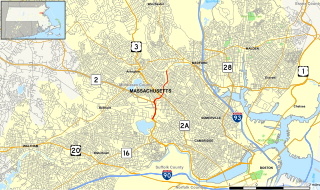
Alewife Brook Parkway is a short parkway in Cambridge and Somerville, Massachusetts. It is listed on the National Register of Historic Places. It begins at Fresh Pond in Cambridge, and heads north on the east bank of Alewife Brook, crossing into West Somerville and ending at the Mystic River on the Medford town line, where it becomes Mystic Valley Parkway. The entire length of Alewife Brook Parkway is designated as part of Massachusetts Route 16 (Route 16), while the southernmost sections are also designated as part of Route 2 and U.S. Route 3 (US 3). It is managed by the Department of Conservation and Recreation with the Massachusetts Department of Transportation responsible for bridge maintenance.
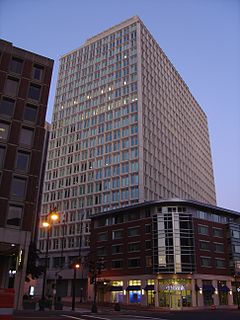
100 Cambridge Street, formerly the Leverett Saltonstall Building, is a high-rise building located in the Government Center district of Boston, Massachusetts. The building stands at 396 feet with 22 floors. It was completed in 1965 and underwent major renovation and expansion in the early 2000s. The building is just a few feet shorter than the 400-foot height required for inclusion on the list of tallest buildings in Boston. The architectural firm that designed the building was Emery Roth & Sons. The building is notable for its distinctive International style architecture. The building was named in 1969 for former Massachusetts governor and United States Senator Leverett Saltonstall until its closure in 1999. When first opened it housed state offices; it now houses a mix of residential, commercial, and state tenants. Since October 2017, it has been the home of Sattler College.

Columbia Point, in the Dorchester neighborhood of Boston, Massachusetts sits on a peninsula jutting out from the mainland of eastern Dorchester into the bay. Old Harbor Park is on the north side, adjacent to Old Harbor, part of Dorchester Bay. The peninsula is primarily occupied by Harbor Point, the University of Massachusetts Boston, the John F. Kennedy Presidential Library and Museum, the Edward M. Kennedy Institute for the United States Senate, and a complex at the former Bayside Expo Center, Boston College High School, and the Massachusetts Archives. The Boston Harborwalk follows the entire coastline.
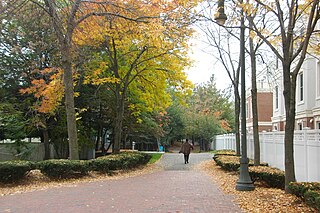
North Cambridge, also known as "Area 11", is a neighborhood of Cambridge, Massachusetts bounded by Porter Square and the Fitchburg Line railroad tracks on the south, the city of Somerville on the northeast, Alewife Brook and the town of Arlington on the northwest, and the town of Belmont on the west. In 2005 it had a population of 10,642 residents living in 4,699 households, and the average income was $44,784. In 2010, the racial demographics for the neighborhood were 57.6% White, 20% Black, 15.1% Asian/Pacific Islander, 7.3% Hispanic origin, 0.3% Native American, 2.4% other race.
Cambridge Highlands also known as "Area 12", is a neighborhood of Cambridge, Massachusetts bounded by the railroad tracks on the north and east, the Belmont town line on the west, and Fresh Pond on the south. In 2005 it had a population of 673 residents living in 281 households, and the average household income was $56,500.
The Old Harbor Housing Project, later renamed the Mary Ellen McCormack Project, is a 27-acre housing project opposite Joe Moakley Park in South Boston, Massachusetts.
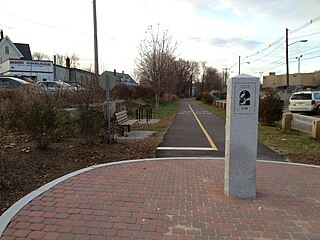
The Watertown Branch Railroad was a branch loop of the Fitchburg Railroad that was meant to serve the town of Watertown and the City of Waltham, Middlesex County, Massachusetts, as an independent short line railroad; it also serviced the Watertown Arsenal. The line has been formally abandoned and portions are being converted into a rail trail, the Watertown-Cambridge Greenway. A section from School Street to Arlington Street in Watertown has been completed. A small portion in Waltham has been converted into a park called Chemistry Station Park after the railroad station once located there. Construction of an extension to Fresh Pond Reservation in Cambridge began in the summer of 2018 and is expected to be completed in 2021.

Chestnut Hill Realty is a privately held real estate company based in Chestnut Hill, Massachusetts, that specializes in purchasing, renovating, developing, operating and leasing real estate, with a focus on multi-family residential housing.
Seaport Square, or Boston Seaport is a master planned project in the Seaport District of Boston, Massachusetts. It spans 8.5 million square feet and 23 acres (9.3 ha) of land.
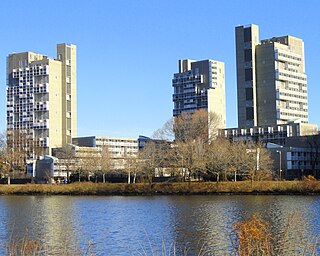
Peabody Terrace, on the north bank of the Charles River in Cambridge, Massachusetts, is a Harvard University housing complex primarily serving graduate students, particularly married students and their families. Designed in the brutalist style and constructed in 1964, its three-story perimeter grows to five and seven stories within, with three interior 22-story towers.
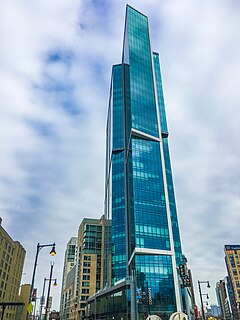
Pierce Boston is a residential apartment and condo building located in the Fenway–Kenmore neighborhood of Boston, Massachusetts (USA), at the corner of Boylston Street and Brookline Avenue. The 30-story mixed-use development includes luxury condo, apartment, and retail components. It is the tallest building in the neighborhood.

















